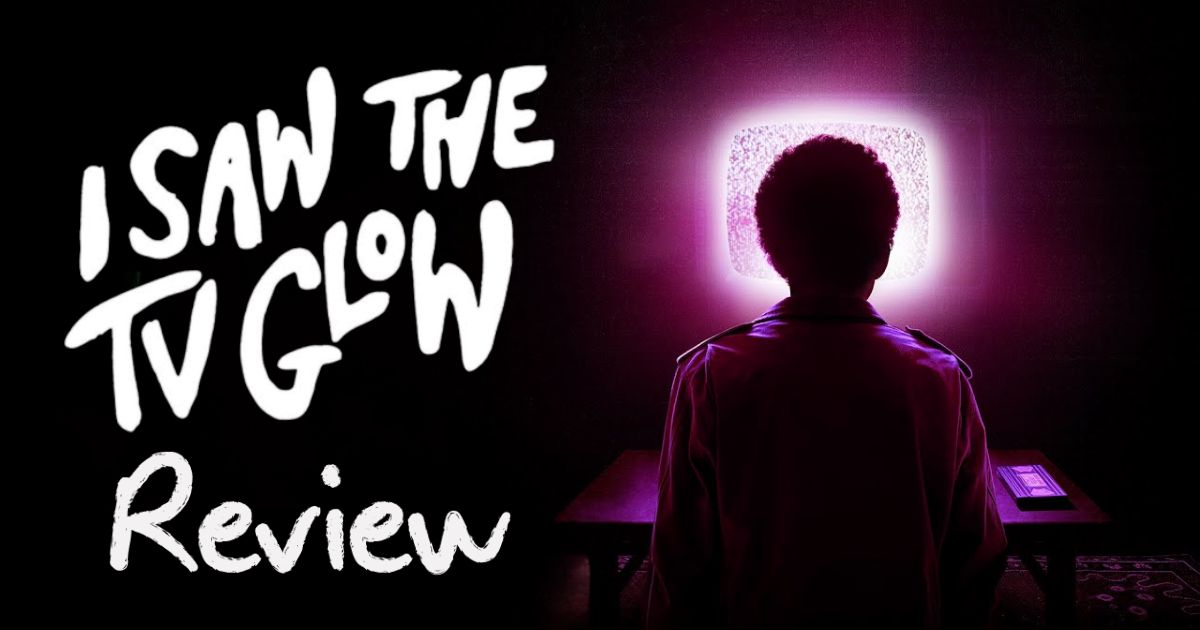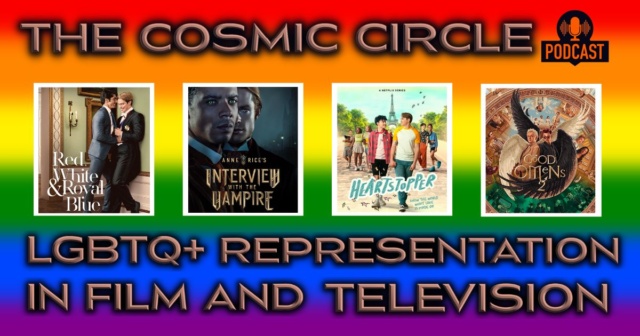‘I Saw the TV Glow’: Pop Culture’s Role in an Unaccepting World

A24’s I Saw The TV Glow features two characters connecting over a childhood program. It’s a movie dissecting how pop culture can unearth something deep inside us. At the same time, how something so mundane, like a song or a kid’s program, can help form connections. However, in the case of I Saw The TV Glow, the hopeful ideas are visualized through the lens of a David Lynch-ian dark wonderland.
The film is written and directed by Jane Schoenbrun, who previously helmed the brilliantly atmospheric film We’re All Going to the World’s Fair. While that movie is hauntingly bleak, there is something sincere and optimistic beneath the eeriness of I Saw The TV Glow. For this writer, it felt like a testament to the coping power of art.
What is I Saw The TV Glow about?
The film centers on two teenagers who are mostly outcasts in school. Maddy (Brigette Lundy-Paine) has a punk rock vibe and speaks with an aggressive cadence, including the times when she intends to be sincere. Owen (Justice Smith) is a mostly reclusive teen with strict parents. He is quiet and is an island to himself.
The two spark a conversation in school about a television show called The Pink Opaque, which involves teen girls with supernatural powers fighting an archenemy named Mr. Melancholy.
Maddy is an unapologetic fan of The Pink Opaque and knows the lore inside and out. Owen has never seen it because it comes on television after his curfew. After befriending Owen, she offers to let him watch the show at her house. But with Owen’s strict parents, he lies about sleeping at a friend’s house to watch the show with Maddy.
The resulting viewing experience forms a bond between them that spans into adulthood. Along the way, The Pink Opaque envelopes their personal lives in unexpected ways. It becomes more than just a show.
An A24 film about art as a gateway to discovery
There are so many films about finding one’s self. Most of them typically focus on the relationship side of the characters. While the film does focus on Maddy and Owen’s relationship, the pop culture aspects feel different. The friendships we form shape us, but the same is true of our tastes in music, movies, and television shows. And sometimes, art can awaken something buried inside: an emotion, an idea, or even a memory. I Saw The TV Glow is a dark, meditative exploration of this concept.
For example, take an angry teenager with no therapeutic outlet. He, she, or they feel alone, and a song suddenly raptures them and informs their feelings. For this writer, as a teenager, it was the discovery of early 2000s rock music. Most of the mainstream artists of the period have aged poorly, but some of the music helped process feelings and develop bonds with others who shared similar interests.
Maddy and Owen consider The Pink Opaque their early 2000s rock anthem. It’s funny because Fred Durst of Limp Bizkit plays Owen’s bigoted father, which almost feels intentionally ironic given the subject matter of art being reevaluated over time.

At first glance, Maddy and Owen appear to be unlikely friends. Maddy, being older, has an intense personality, while Owen is notably reserved, timid, and less self-assured. Then they bond over a Saturday night program; a program Maddy describes as “feeling more real” than everyday life. Anyone who has ever been emotionally affected by a work of art should find this sentiment relatable, especially if the creation can evoke suppressed emotions.
Jane Schoenbrun’s haunting discussion about the LGBTQ+ experience
I Saw the TV Glow delves into the LGBTQ+ experience with relatable themes. Maddy knows her feelings towards women and clarifies she has no romantic feelings for Owen. However, Owen struggles to understand his feelings and comes across as asexual and disconnected at times. Both Maddy and Owen come from abusive households, with Maddy being physically abused by her father and Owen dealing with a father who silently judges and suppresses his identity.
Then there is The Pink Opaque, the television show that connects them. It is a supernatural series about teens with beautiful gifts inside them who are constantly under threat by a moon-shaped deformity known as Mr. Melancholy. The subtext is a vibrant metaphor for the transgender experience.
Filmmaker and screenwriter Jane Schoenbrun also identifies as non-binary. According to the Trevor Project, over 67% of individuals who identify as transgender battle depression, and the Williams Institute also reports that 44% suffer from suicidal ideation. I Saw the TV Glow captures the essence of living this way. It’s an atmospheric journey through the eyes of characters who fear being themselves while depression looms over the suburban land of suppression.
What if David Lynch was sponsored by Claire’s?
The film’s tone is surreal, reminiscent of a David Lynch experience. While some moments are grounded, others are dreamlike with touches of the bizarre. Some scenes confuse the audience’s perception of reality. Characters speak in exaggerated ways, almost theatrically, but for this film, it’s impactful.
In one scene, Brigette Lundy-Paine delivers an intense monologue about The Pink Opaque, the delivery almost feels like spoken word. Lundy-Paine is remarkable here and has a way of speaking dialogue that feels sharp. In these moments, viewers will want more of the actress as they watch her carry a scene with intense expression.
Cinematographer Eric Yue (A Thousand and One) continues using the same color schemes as the ones subtly featured in We’re All Going to the World’s Fair. The aesthetic possesses pink and purple hues and other feminine styles of greens, blues, and “tween”-inspired color palettes. The color scheme is reminiscent of the small store known as Claire’s, a shop aimed at young girls who are interested in glittery items, colorful accessories like bracelets, and potentially getting their ears pierced. The schematics have the color of Claire’s, but if Claire herself was in a bad mood.
Final thoughts on I Saw the TV Glow
The movie is labeled as a horror film, but to be honest, it’s not particularly scary. If there is any terror to be found, it’s in the harsh realities presented in the film—the reality of a world that makes it difficult for people to be themselves. A world not unlike our own. However, there’s something tender and hopeful within the dark and unsettling neon pink ambiance.
At its core, I Saw the TV Glow is about two lost souls trying to support each other in an unaccepting world. The power of storytelling brings them together. As a self-proclaimed misunderstood movie enthusiast, there’s nothing cooler than that.
A24’s I Saw the TV Glow is now showing in theaters. Are you planning to see this film? If you did what did you think of it? Let us know on social media @mycosmiccircus or in The Cosmic Circus Discord.
Review: Kingdom of the Planet of the Apes




